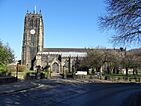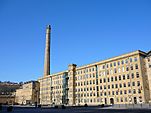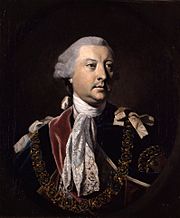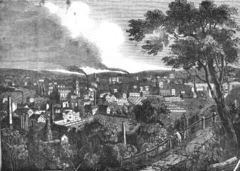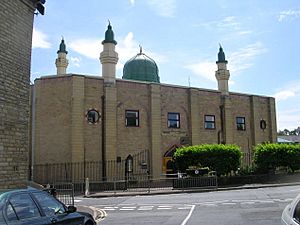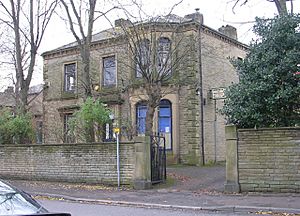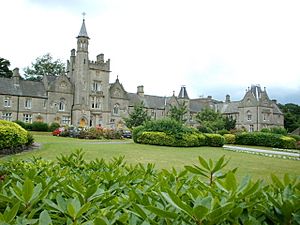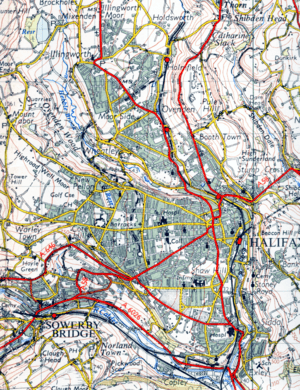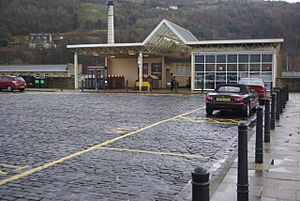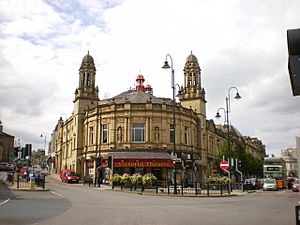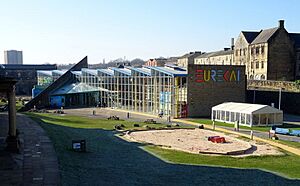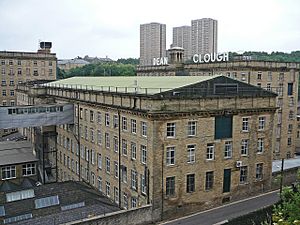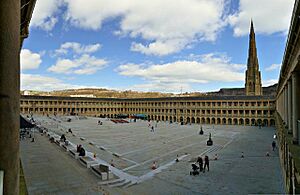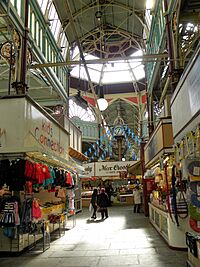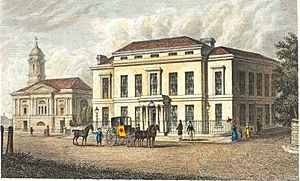Halifax, West Yorkshire facts for kids
Quick facts for kids Halifax |
|
|---|---|
| Town | |
|
|
 Coat of arms |
|
| Population | 88,134 (2011 Census) |
| Demonym | Haligonian |
| OS grid reference | SE090254 |
| • London | 165 mi (266 km) S |
| Metropolitan borough |
|
| Metropolitan county | |
| Region | |
| Country | England |
| Sovereign state | United Kingdom |
| Post town | HALIFAX |
| Postcode district | HX1–HX4 |
| Dialling code | 01422 |
| Police | West Yorkshire |
| Fire | West Yorkshire |
| Ambulance | Yorkshire |
| EU Parliament | Yorkshire and the Humber |
| UK Parliament |
|
Halifax is a lively town in West Yorkshire, England. It sits at the eastern edge of the Pennines hills. For hundreds of years, Halifax has been an important place for making things. In the 15th century, it was famous for its wool trade. Later, during the Industrial Revolution, it became a busy mill town. Today, Halifax is home to about 88,000 people and is the main town of the wider Calderdale area.
Contents
- What's in a Name? The Story of Halifax
- A Glimpse into Halifax's Past
- Where is Halifax?
- Who Lives in Halifax?
- Halifax's Economy: From Wool to Chocolate
- Getting Around Halifax
- Media and News in Halifax
- Learning in Halifax
- Halifax's Culture and Fun
- Famous Places to See in Halifax
- Sports in Halifax
- Places of Worship in Halifax
- Famous People from Halifax
- See also
What's in a Name? The Story of Halifax
The name Halifax was first written down around 1091. It comes from old English words, halh-gefeaxe. This means "an area of rough grass in a corner of land."
The title "Earl of Halifax" was created after the town. In 1749, the city of Halifax in Canada was named after George Montagu-Dunk, 2nd Earl of Halifax. He was an important leader at the time. Even the Halifax River in Florida, USA, got its name from him!
A Glimpse into Halifax's Past
Halifax isn't mentioned in the famous Domesday Book from 1086. But by the 1100s, it was a key religious spot for a large area. Halifax Minster, a church that started in the 12th century, is dedicated to St John the Baptist. Did you know that William Herschel, who discovered the planet Uranus, was once the Minster's organ player in 1766?
Halifax was once known for its gibbet. This was an early type of guillotine used to execute criminals. It was last used in 1650. You can see a copy of it on Gibbet Street today. The original blade is kept at Bankfield Museum.
In the 1800s, Halifax became very wealthy. This was thanks to its cotton, wool, and carpet factories. Like many towns in Yorkshire, it had many mills. Many of these old buildings have now been changed for other uses.
The well-known Halifax bank started here in 1853. It began as a building society to help people save money. Today, it's part of the Lloyds Banking Group. Halifax is also a twin town with Aachen in Germany.
Where is Halifax?
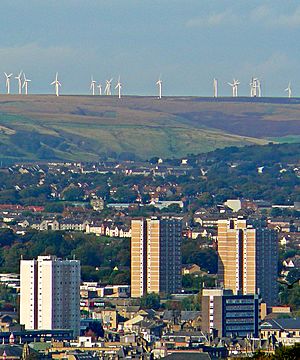
Halifax is located in the south-eastern part of the South Pennines moorland. It's about 4 miles (6 km) from the M62 motorway. This makes it easy to reach cities like Bradford and Huddersfield. The Hebble Brook river in Halifax flows into the River Calder.
Who Lives in Halifax?
In 2004, about 82,500 people lived in the Halifax urban area. Most residents are White (87%), followed by British Pakistani (10%). Most people aged 16–74 have jobs, many of them full-time.
Halifax has a large community from South Asia, mainly British Pakistanis from the Kashmir region. They first came to the area to work in the textile factories. Most of this community lives in west central Halifax. Other areas like Illingworth and Mixenden have mostly White residents.
Halifax's Economy: From Wool to Chocolate

Since 1779, traders used the grand Piece Hall to sell woollen cloth around the world. Today, the Piece Hall is a public market with many unique shops and cafes. It also hosts events and an industrial museum.
Halifax is famous for Mackintosh's chocolate and toffee. This includes popular sweets like Rolo and Quality Street. John Mackintosh and his wife, Violet, started a toffee shop in 1890. Violet created the toffee recipe. Their son Harold grew the business into a global company. In 1988, Nestlé bought the company.
Dean Clough, just north of the town centre, was once one of the biggest textile factories in the world. It was over half a mile long! Now, it's a modern business park with offices, shops, a gym, a theatre, and even a hotel.
Halifax was also a busy town for making carpets, tools, and beer. The Crossley family, who made carpets, were very kind. Joseph and Sir Francis Crossley built special homes for their workers, which are still used today. Halifax is also home to Suma Wholefoods, the UK's largest workers' co-operative. This means the business is owned and run by its employees.
Getting Around Halifax
You can get around Halifax using public buses and trains. These services are managed by West Yorkshire Metro. In 2010, Halifax got a direct train link to London, which was a big deal for the town!
Bus Services
Most buses leave from Halifax bus station. First West Yorkshire runs most services in the town. Other companies like Yorkshire Tiger and Arriva Yorkshire connect Halifax to nearby towns like Dewsbury, Wakefield, Huddersfield, Bradford, and Leeds. Some buses even go to other counties, like Rochdale in Greater Manchester and Burnley in Lancashire.
Train Services
Halifax railway station is on the Calder Valley line. You can catch trains to Manchester Victoria, York, Selby, Bradford Interchange, Leeds, and Blackpool North. There are also services to Huddersfield, Wakefield Westgate, and the direct service to London King's Cross.
Some old railway lines around Halifax are now walking and cycling paths. One campaign is trying to save and restore the long Queensbury Tunnel for walkers and cyclists.
Media and News in Halifax
Halifax has several local radio stations, including BBC Radio Leeds, Hits Radio West Yorkshire, Heart Yorkshire, Capital Yorkshire, and Phoenix Radio. Sunrise Radio (Yorkshire) is also expanding its coverage to Halifax.
For TV news, you can watch BBC Yorkshire and ITV Yorkshire. The local weekly newspaper is called the Courier, and its offices are in town.
Learning in Halifax
Halifax is home to two excellent grammar schools: the Crossley Heath School and North Halifax Grammar School. Both schools are known for their great exam results.
Calderdale College is a college for further education. In 2007, it partnered with Leeds Beckett University to open 'University Centre Calderdale' for higher education. In 2019, Trinity Sixth Form opened in the town centre. It offers great further education for students aged 16 to 18.
Halifax's Culture and Fun
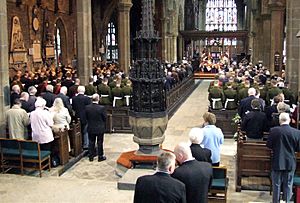
The Duke of Wellington's Regiment (West Riding) has strong ties to Halifax. Their old flags, called "regimental colours," are kept in the Halifax Minster. Some of these flags are very old, including ones used during the Battle of Waterloo!
Eureka! The National Children's Museum is a fantastic place for kids. It was opened by King Charles III (when he was Prince of Wales) in 1992 and is located near the railway station.
Halifax also has a lively nightlife, especially around Georges Square. It's even home to Britain's oldest nightclub, The Acapulco, which opened in the 1960s!
Dean Clough Mill: A Transformed Landmark
Dean Clough Mill was once the world's largest carpet factory. It was built in the 1840s-1860s by John Crossley. Its tall, triangular chimney, built in 1857, stands out in the skyline.
In the 1980s, the mill was turned into a business park. Today, it hosts theatre companies, art galleries, and artist studios. It's a great example of how old industrial buildings can be given new life.
Famous Places to See in Halifax
- Piece Hall: This amazing building was once a trading hall for woollen cloth. It opened in 1779. Now, it's a public market with unique shops, cafes, and events. It recently had a big makeover!
- Halifax Minster: A beautiful old church with parts dating back to the 12th century.
- Halifax Town Hall: Designed in 1863 by Charles Barry, who also designed the Houses of Parliament.
- Borough Market: A Victorian indoor market in the town centre. It's currently being updated.
- Wainhouse Tower: A very tall, unusual tower at King Cross. Built between 1871 and 1875, it was meant to be a chimney but became a "folly" (a building built for decoration). It's the tallest folly in the world! You can sometimes climb it on bank holidays.
- People's Park: A public park designed by Joseph Paxton. It was given to the people of Halifax in 1857.
- Shibden Hall: Just outside Halifax, this historic house was once the home of the famous diarist Anne Lister.
- North Bridge: A Victorian bridge built in the Gothic Revival style.
Sports in Halifax
Halifax has successful sports teams. The rugby league club, Halifax Panthers, plays in the RFL Championship. The town's football team, FC Halifax Town, plays in the National League. There's also a women's football team, Halifax FC Women.
Football
The Shay football ground has been the home of the town's football club since 1921. It has been greatly improved over the years.
Rugby League
Halifax Panthers is a very old rugby league club, started in 1873. They have won the English Championship four times and the Challenge Cup five times. Many amateur rugby league clubs are also based in or near Halifax.
Rugby Union
Halifax has several senior rugby union clubs, including Halifax, Halifax Vandals, Heath, Old Crossleyans, Old Rishworthians, and Old Brodleians.
Swimming
Halifax Swimming Pool opened in 1966. It has cool ceramic artworks by Kenneth Barden showing British pond life.
Places of Worship in Halifax
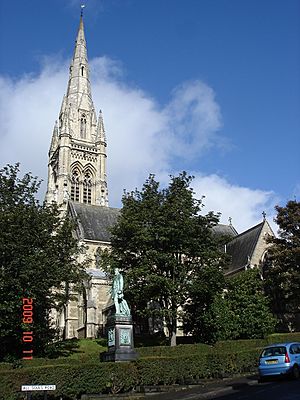
The 15th-century Minster is dedicated to St. John the Baptist. It became a Minster in 2009. It has rare old glass windows and a collection of Jacobean wooden pews.
St Mary's Roman Catholic Church was built in 1839. The Serbian Orthodox Church in Boothtown was once a Methodist chapel. It was bought by the town's Serbian community in 1956.
All Souls' Church is a beautiful Victorian church with a tall spire. It was paid for by mill owner Edward Akroyd. It has amazing windows by famous artists of the 1850s.
Other churches include the old Georgian Holy Trinity Church (now offices) and the Gothic Revival St. Paul's at King Cross.
Famous People from Halifax
- Tom Bailey: Singer from the band Thompson Twins.
- Phyllis Bentley: A well-known novelist.
- Henry Briggs: A famous mathematician.
- Kenny Carter: Speedway Rider and British Champion.
- Hannah Cockroft: An amazing athlete and double Paralympic gold medallist.
- Shirley Crabtree: A wrestler known as 'Big Daddy'.
- George Dyson: A talented composer.
- Jonathan Fairbanks: Builder of the historic Fairbanks House in Massachusetts, USA.
- David Hartley: A philosopher.
- Charlie Hodgson: Rugby union player for England.
- John Mackintosh: Creator of Mackintosh's Toffee.
- Harold Vincent Mackintosh: His son, who grew the chocolate business.
- Brian Moore: Rugby union player and TV presenter.
- John Noakes: A popular TV presenter.
- Wilfred Pickles: An actor and radio presenter.
- Jesse Ramsden: Inventor of the Ramsden theodolite (a surveying tool).
- Sir Henry Savile: A bible translator.
- Percy Shaw: Inventor of cat's eyes for roads.
- Ed Sheeran: A world-famous singer-songwriter.
- Oliver Smithies: A Nobel Prize winning geneticist.
- Herbert Akroyd Stuart: Inventor of the hot-bulb engine.
- Brian Turner: A well-known chef and TV personality.
- John E. Walker: A Nobel Prize winning chemist.
- Dorothy Wordsworth: Diarist and sister of the poet William Wordsworth.
- Frank Worthington: A famous footballer.
See also
 In Spanish: Halifax (Yorkshire del Oeste) para niños
In Spanish: Halifax (Yorkshire del Oeste) para niños



